NEWFOUNDLAND (says Mr.
Morris) was a dependency of England, her only colony a century before
Massachusetts, New York or Virginia, emerged from barbarism. When the
‘untutored Indian' uncontrolled by civilized man, roamed through these
now busy marts, redundant with wealth, population, and all the
advantages of civilization, Newfoundland was resorted to by thousands of
British, Spaniards, French and Portuguese; and millions were drawn from
her mines—the fisheries—far more valuable than those of Mexico and
Peru.”
McGregor, in his
British America, says :—
“Newfoundland, although
occupying no distinguished place in the history of the New World, has,
notwithstanding, at least for two centuries and a half after its
discovery by Cabot, in 1497, been of more mighty importance to Great
Britain than any other colony; and it is doubtful if the British Empire
could have risen to its great and superior rank among the nations of the
earth, if any other power had held the possession of Newfoundland; its
fishery having, ever since its commencement, furnished our navy with a
great proportion of its hardy and brave sailors.”
And the first Mr. Pitt,
in declaiming upon the national interests of Great Britain, affirmed
that one point was of such moment, as not to be surrendered, though the
enemy was master of the Tower of London;—the Newfoundland fisheries. The
Europeans first began the fishery on the Newfoundland coast, in 1502.
The Portuguese were the first; and subsequently the Biscayans, and the
French. In 1578, the Portuguese had 50 vessels engaged in the fishery;
the English also 50; and the French and Spanish 150. So important had
this fishery become, that in the year 1(534, France consented to pay a
tribute of Jive per cent, to the British Government, rather than
relinquish the privilege of fishing on the coast; which continued until
the reign of Charles II., a period of forty-one years. In 17(53, France
removed all her -pretensions to Nova Scotia, for the privilege of
fishing on the northern parts of Newfoundland ; from this time the
French fishery rapidly increased. In 1721, France employed 400 .ships in
the Newfoundland fishery. The Grand Bank, or deep sea fishery at one
time, gave employment to 400 British ships, manned by 7,000 men; and
during the last war, 700 ships were employed on the Banks.
This important fishery
is now wholly in the hand of the French and Americans, not a single
British ship is now employed in the fisheries on the Banks of
Newfoundland. Mr. Morris, late Colonial Treasurer of Newfoundland, says:
—“Why do not British ships resort to the Banks as formerly? The reason
is at hand—because under the present unequal and unnatural competition,
nothing but the most certain ruin would be entailed on the British, if
they ventured into the Bank and deep-sea fisheries. The price of fish
reduced far below its intrinsic value, in all the markets of the world,
common to these three nations, by the competition of the French and
Americans, would not pay one-half the outfit. A British merchant fitting
out a ship of 250 or 300 tons for the Bank fishery in the same manner in
which the French fit out their vessels, would, at the present price of
fish, calculate upon a certain loss of $4,000 to $5,000. This cause
operates as the most effectual prohibition.
The French have adopted
a new mode of fishing on the Banks, their vessels anchor, which was not
allowed in former times, they have also adopted what is called the
Bultow system, and which is clearly explained in a memorial presented by
Messrs. Mudge & Co., to the late Governor of Newfoundland, Sir John
Harvey.
“ That the Bultow
system is carried on in the following manner :—The vessel is provided
with two or three large boats, of a size fit to carry out, at
considerable distances, large supplies of rope and line, with moorings
and anchors sufficient to ride at anchor on the open Bank in rough
weather. These boats carry out from five to six thousand fathoms of rope
to which are fastened leads, with baited hooks at certain distances from
each other. These are carried out from the vessels in different
directions and let down and secured with suitable moorings, to prevent
their being carried away by the strong currents that usually prevail on
the Bank. They are then laid out at stated distances from each other,
with several thousand hooks well baited, and frequently occupy several
miles of ground. On the next day they are taken up and overhauled—the
fish taken off, —and, if the berth is approved, the hooks fresh baited
and let down again, and thus successively during the voyage. But should
the berth in which they have anchored not prove a good one, they heave
up and sail about to make another, in doing which, if they chance to see
an English vessel catching fish freely with hook and line, they anchor
near her and lay out their Bultows, which, spreading so large a quantity
of bait, the fish are soon drawn thereby from the few caplin presented
by the English vessel, and the latter is therefore obliged to heave up
and sail away from the good fishing ground, to find a berth elsewhere:
so that not only does the English vessel lose the good fishing in which
she was engaged, but the most valuable part of the season is often lost
in wandering about to find a new berth clear of the French ships; for
they are so numerous, and each covers with its Bultows so large a space,
that it would be difficult to keep clear of them, and any place near
them it is, for the reasons above stated, useless to attempt occcupying;
so that in effect the French have monopolized to themselves all the best
fishing ground.
“Your Memorialists’
vessel fell in with one of these Bultows, which had gone adrift,
measuring 1,500 fathoms.
“To show the working of
the French system of bounties in their Newfoundland Fisheries, and to
prove the hopelessness of competition on the part of the British
merchant and fisherman, it is only necessary to exhibit a statement of
the outfit and returns of a French ship of three hundred tons on the
Grand Bank S of Newfoundland, procured by a gentleman who recently
arrived from St. Pierre and Miquelon, and the results of the last
season’s voyage of 1846.
“Vessels of 150 tons
from France are obliged to bring out 30 men and boys, one boy under 15
years of age to every ten men.
“Vessels over 150 tons
are obliged to bring out 50 men and boys.
“The bounty on every
man and boy is 50 francs, and on fish 10 francs.
“Boys receive as wages
50 francs for the season. Men receive a portion of the voyage and from
50 to 100 francs each. The voyage is divided by three, two-thirds to the
owners, and one-third to the crew. The master, in addition to his wages,
which vary from 70 to 100 francs per month, receives two men’s share of
fish; for example, one ship in 1846 landed 132,000 fish; equal to 5,280
quintals, with a crew of 18 men.
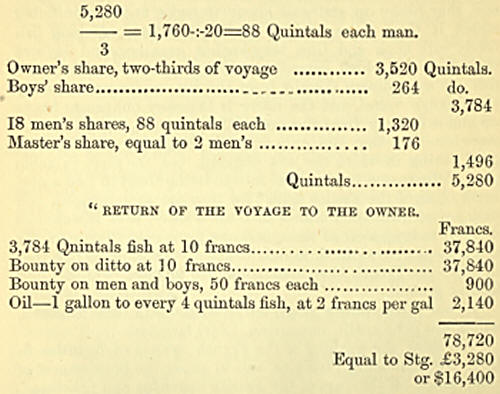
“According to the
statement, the French merchant obtains in the form of bounty, 10 francs,
say 8s. 4d. sterling, which, with the bounties for the men and boys, and
the drawbacks on the necessaries for the supply of the voyage, raises it
to at least 10s. stg. per quintal. If he obtains 10s. for the fish at
market it will realize 20s. per quintal. Let the case of the British
merchant, who fits out a ship for the Grand Bank, be placed in
juxtaposition; he has to sell his fish in the markets of the world, open
alike to both, the price is regulated for him by the sale of the bounty
fish of the French. He receives 10s;, while the French merchant realizes
20s. Such disparity puts an end to all competition, the Biitish
merchant, as a matter of necessity, has to surrender the Fishery
altogether into the hands of his protected rivals. In the year 1838, the
writer had the honour of an interview with Sir George Grey, at the
Colonial Office. In bringing this subject under his consideration, he
supposed an example of two cloth manufacturers, having warehouses for
the sale of their wares at Cheapside, one had a bounty of 5s. per yard
for every yard of cloth he manufactured, the other no bounty; the
competition could not be maintained without a ruinous sacrifice on the
part of the latter. This is not an inapt simile to show the ruinous
competition which the British in the Newfoundland Fisheries have to
maintain with their foreign and more favoured rivals.”
The following Return of
the French bounties was obtained by the British Ambassador at Paris, in
1848 :—
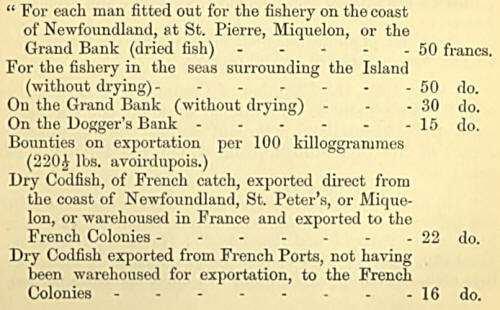
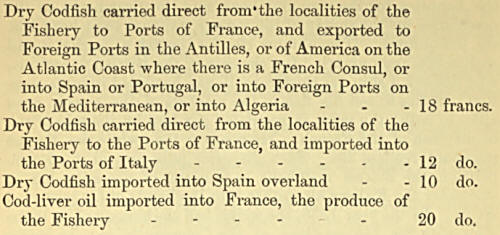
“Total Bounties Paid in
1844, ’45, '46.

“Drawback of all duties
on salt used in the curing of the fish, except 50 centimes (4½d. stg.)
per 100 kilog. on foreign salt imported for the coast of Newfoundland,
St. Pierre and Miquelon fishery.
“Drawback of all duties
on all the outfit for the fishery, including vessels employed and all
utensils.”
In May, 1830, the
Chamber of Commerce of St. John s sent Mr. Sweetland to the French shore
on the northern coast of Newfoundland, who laid before the Chamber a
report of his proceedings, from which the following is taken:—
“The number of ships
employed this season by the French in this fishery were 266 in all,
viz.—From Granville, 116; St. Malo, 110; Paimpol and Bennick, 30; Havre,
4; Nantes, 6. Total 266, from 100 to 350 tons burden, having 51 men and
boys each, amounting in the whole to 13,566, one tenth portion of whom
were boys. This number surpassed considerably the Governor’s estimate, a
very good one, which was assigned to me by the French gentleman from
whom I received the information. Each establishment had two. some four,
cod seines from sixteen to thirty fathoms deep, and 200 fathoms long.
Their caplin seines were from twenty-one feet to fifty in depth; two
were held by each establishment. The cost of a cod seine crew amounted,
for the season, to 6,000 livres, and the catch thereof to 1,200
quintals. The allowance for each man for the season, commencing at the
first day of May and ending on arrival in France, on or about the first
day of November, 35 lbs. pork, 35 lbs. butter, 3J cwt. bread, 40 lbs.
peas, 6 gallons of brandy, f tierce cider— in all equal to about £8.
sterling ; boat-masters, or principal men, are paid about £10 as wages,
an ordinary fisherman £7, and boys £3 less, a sum equal to £2 10s.
allowed on each man as a bounty by their government. In 1829, their
catch of fish amounted to 350,000 quintals—45 quintals for each person
employed—an average catch and good voyage.
“At this period their
bounties were extremely liberal, therefore, supposing the merchants were
allowed on each man employed 60 livres, or 50s. each on 13,566 men,
£33,915.
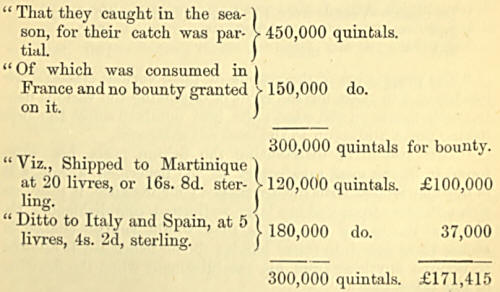
“£171,415 sterling paid
in bounty, besides materials granted the fisherman in addition. In fact,
the fishery is for the purpose of training seamen for their navy, and
consequently is a national undertaking rather than the pursuit of
private individuals.”
The following account
of the French fisheries is given by Commander Fortin to the Canadian
Government in 1862
“France looks upon the
Newfoundland fisheries as the true school for the French marine, and it
is here that she forms the nursery of hardy sailors whom she requires to
man her fleets ; and of so great importance does she consider them to
be, that she every year employs for their protection three steam war
vessels and two armed schooners.
“Numerous laws,
regulations and decrees of the commandant of St. Pierre regulate the
French fisheries at Newfoundland; but I do not consider it necessary to
dilate here upon any of them except those which relate to the cod
fishery carried on on the coast of that island, and the possession of
the land necessary for the working of this branch of industry.
“The vessels which are
fitted out in France for the New foundland fishery are divided into
three classes:
“1st class.—Vessels
over 158 tons and under 400 tons.
“2nd “ — “ “ 100 “ “ 158 “
“3rd “ — “ under 100 “
“The proprietors of the
vessels of these various classes draw lots every five years for the
right of occupying the various fishing settlements on the coast ; the
best numbers select the best fishing posts, and so on to the least
advantageous.
“This system of
distributing the fishing posts has been found to be the most
satisfactory to the fishermen, although it is not unattended with
inconvenience; for instance, it prevents rich outfitters from making
large well-fitted establishments, because, at the end of five years,
they would run the chance of seeing them pass into other hands; for no
fisherman is allowed to remove anything from his establishment when the
drawing of lots takes place.
“The last drawing took
place this spring, and there were one hundred and eleven vessels in the
first class, and nearlj as many in each of the other two.
“Vessels of the first
class should have a crew of at least sixty-five men and boys; of the
second, forty-five; and of the third, thirty ; which give a total of ten
or twelve thousand fishermen employed in the French fisheries on the
coast of Newfoundland, from Cape St. John on the east to St. George’s
Bay on the west.
“The principal
regulations which relate to the cod fishing are those which forbid the
use of deep sea or trolling lines in the taking of that fish, and only
allow the use of cod fish nets afloat; all fishermen are strictly
forbidden to draw or land a cod fish net, or even a caplin net on the
shore, without doubt, in order that those fish may not be disturbed
while engaged near the shore in the reproduction of their species.
“The French do not make
much use of the line in the cod fishery on the north coast of
Newfoundland. They use chiefly very large nets which are nearly all 150
fathoms long and 30 fathoms wide. Nearly forty men are required to
handle them successfully ; they are very costly. But on the other hand
vast quantities of fish are taken with these immense nets ; 50, 100, and
even as many as 200 quintals of cod, or 5,000, 10,000 and 20,000 fish.
“But it is a necessary
condition that the fish should run in shoals and be plentiful on the
fishing grounds; unless this is the case, the net fishing yields but
little, and the outfitter’s loss is then enormous.
“The cod this year was
not plentiful on the coast of Quirpon, and the fishermen of that place,
including Messrs. Robinot and Durand, had in consequence suffered a
proportionate loss, as they have but little cod to export, and will
accordingly receive but a small sum as premium.
“There are at Quirpon
seven fishing establishments belonging, for the most part, to St. Malo
and St. Servan; these employ eighteen ships of from two to five hundred
tons. We saw one of them, a fine ship of 500 tons, sail with a cargo of
dried cod fish for the Bourbon Islands and the Mauritius, which are in
great part supplied with fish by the French.
“The French fishermen
are compelled to bring from France almost everything which they require
in carrying on their business ; lumber, boards, planks, pieces of elm
aril oak to repair their boats and vessels, flour, pork, butter, &c.,
&c., the island of Newfoundland not producing any of these articles.
And of these they
consume every year a very large quantity, and the cost of such articles
in France is generally much greater than in Canada ; and it certainly
would bo greatly to the advantage of the French fishermen to come and
buy of us the greater part of the supplies which they require.
“But it may be asked :
if there is any profit to be made, how is it that the French shippers
have not before now taken advantage of the low prices in our market, and
why, on the other hand, have not the Canadian traders entered into
commercial relations with the French fishermen, and despatched to them
cargoes of flour, provisions and wood, suitable to supply their
requirements
“To this I reply that
it results from two principal causes. In France little is known of the
varied resources of Canada, and here, until late years, the nature,
extent, importance and requirements of the French fisheries at
Newfoundland have been ignored.
“For more detailed
information on this subject, my report of 1S58 on St. Pierre and
Miquelon may be consulted.
“I do not pretend, and
I do not wish to be understood, to say that very important commercial
relations could be established between the Canadian traders and the
French shippers and fishermen of Newfoundland; but what I consider quite
possible, and what I am desirous of seeing realized for the mutual
benefit of shipper's and traders, both Canadian and French, in
Newfoundland, is that Canada, and principally Quebec and (laspc, should
supply the latter with the wood and the provisions which are
indispensable to them, and should in return receive French products,
especially French cordage, which is of superior quality, and of which
the consumption on our ships would be very great.
“This trade would give
employment to ten of our schooners to begin with, and at a later period
that number would increase.’'
The French annually
employ about 560 vessels in the Newfoundland fishery, of from 100 to 500
tons burthen, manned by upwards of 20,000 fishermen. About half of this
number prosecute the Bank fishery from the French Islands of St. Pierre
and Miquelon, on the south-west coast; the other half at the French
shore on the northern coast. The quantity of fish taken by them is
estimated at over 1,000,000 quintals annually. The amount of bounties
paid in 1828 is said to have been $625,000; in 1832, $300,000; and in
1846, $905,000. (For an account of the fisheries of St. Peters’, see
Fortune Bay).
The British Fisheries
of Newfoundland, in some places, commence in May, and at other places,
not until the middle of June. About the beginning of June the vessels
sail for the Labrador Fishery. The manner of catching and curing the
fish has been so often described, and is now so well known, that it is
unnecessary for me to repeat it here.
The price of fish is
regulated by the demand of the foreign markets.

The following is the
produce of the British fisheries of Newfoundland at different periods,
all of which were exported:
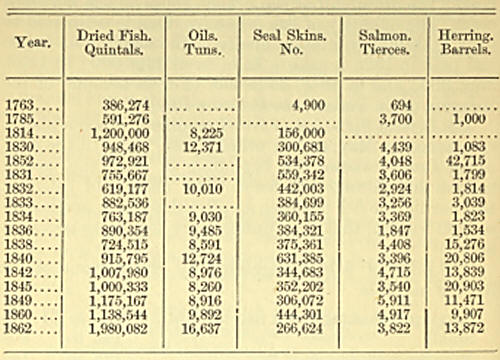
The following Table
will show the state of the British fisheries at different periods, given
by the Committee of Privy Council for Trade, dated Whitehall, 19th
March, 1793
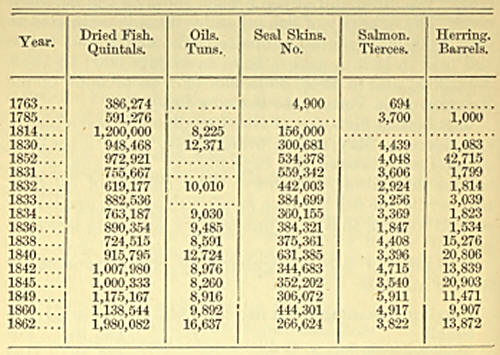
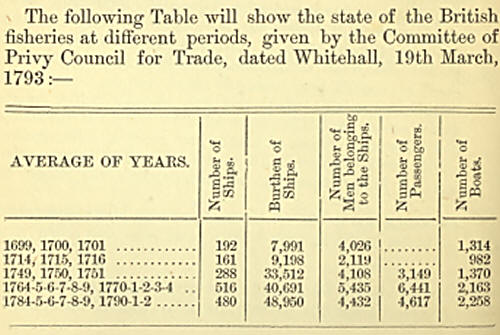
The number of vessels
employed in the Fisheries is about 800, from 80 to 180 tons burthen,
besides coastwise. There are 1,300 more vessels employed in the Foreign
Trade, principally in carrying fish and oil to market. The number of
boats employed in the fishery is 11,693, capable of carrying from 4 to
100 quintals of green fish. The number of persons employed in the
Newfoundland and Labrador Fishery, is about 50,000. The Labrador Fishery
is principally carried on from the Ports of St. John’s. Harbour Grace,
Carbonear, and Brigus. (For a more detailed account, see Labrador).
The following account
of the Labrador Fishery is given by Mr. McGregor:
“During the fishing
season, from 280 to 300 schooners proceed from Newfoundland to the
different fishing stations on the coast of Labrador, where about 20,000
British subjects are employed for the season. About one-third of the
schooners make two voyages, loaded with dry fish, back to Newfoundland
during the summer; and several merchant vessels proceed from Labrador
with their cargoes direct to Europe, leaving, generally, full cargoes
for the fishing vessels to carry to Newfoundland. A considerable part of
the fish of the second voyage is in a green or pickled state, and dried
afterwards at Newfoundland. Eight or nine schooners from Quebec frequent
the coast, having on board about 80 seamen and 100 fishermen. Some of
the fish caught by them is sent to Europe, and the rest carried to
Quebec; besides which, they carry annually about £6,000 worth of furs,
oil and salmon to Canada. From Nova Scotia and New Brunswick, but
chiefly from the former, 100 to 120 vessels resort to Labrador: the
burden of these vessels may amount to 6,000 or 7,000 tons, carrying
about 1,200 seamen and fishermen. They generally carry the principal
part of their cargoes home in a green state.
“One-third of the
resident inhabitants are English, Irish, or Jersey servants, left in
charge of the property in the fishing rooms, and who also employ
themselves, in the spring and fall, catching seals in nets. The other
two-thirds live constantly at Labrador, as furriers and seal-catchers,
on their own account, but chiefly in the former capacity, during winter,
and all are engaged in the fisheries during the summer. Half of these
people are Jerseymen and Canadians, most of whom have families.
“From 16,000 to 18,000
seals are taken at Labrador in the beginning of winter and in spring.
They are very large ; and the Canadians, and other winter residents, are
said to feast and fatten on their flesh. About 4,000 of these seals are
killed by the Esquimaux. The whole number caught produce about 350 tons
of oil—value about £8,000. There are six or seven English houses, and
four or five Jersey houses, established at
Labrador, unconnected
with Newfoundland, who export their fish and oil direct to Europe. The
quantity exported in 1831 to the Mediterranean was about—
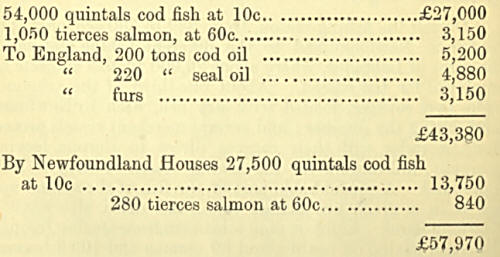
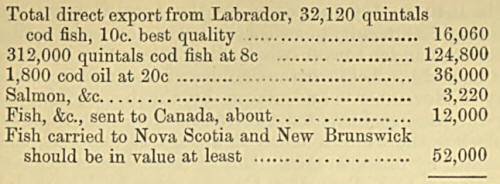
Estimated value of the
produce of Labrador, exclusive of what the Moravians send to
London£302,050
“These statements are
made at the most depressed prices, and not at the average prices, which
would increase the gross value to £342,400.”
It is estimated, that
the Americans employ about 500 vessels, of from 50 to 180 tons burthen,
manned by 5,000 men, on the Newfoundland and Labrador coast, and the
quantity of fish taken by them is 400,000 quintals of cod fish.
The total quantity of
cod fish, taken on the Newfoundland coast annually, may be fairly
estimated as follows:—

The Whale Fishery on
the Newfoundland coast is not important. From 1795 to 1807 Massachussets
employed twelve vessels on the south-west coast. But when the war
commenced with Great Britain, the American whale fishery on the
Newfoundland coast was discontinued.
In 1840, an Act was
passed by the Local Government, offering £200bounty to each of the first
three vessels landing not less than ten tons of whale oil, or fifteen
tons of whale fat or blubber, between the first day of May and the tenth
day of November. Encouraged by the bounty afforded by the passing of
this Act, two vessels were sent from St. John’s to the western shore, of
about 120 tons each, and manned by nineteen men. One of these vessels
was sent by Messrs. C. F. Bennett & Co., the other by Messrs. Job
Brothers & Co.
The result of each
year’s fishery was as follows :—
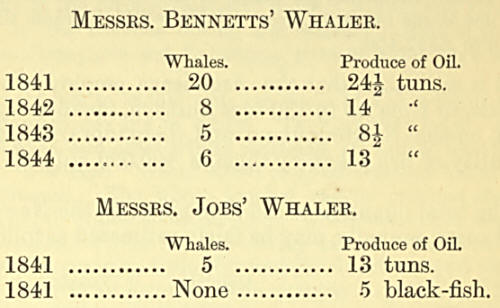
Messrs. Newman &; Co.,
at Fortune Bay, during the above years, also pursued the whale fishery.
They take annually between 40 and 50 whales. The greatest quantity of
whale oil ever manufactured by them in one year was about 150 tuns (in
Fortune Bay). In 1866, Messrs. Ridly, of Harbour Grace sent a vessel to
Greenland whale fisheries, she returned in September with about 50 tuns
of oil. The seal fishery of Newfoundland has assumed a degree of
importance far surpassing the most sanguine expectations of those who
first embarked in the enterprise, and is now become one of the greatest
sources of wealth to the country. The interest of every individual is
interwoven with it, “ from the bustling and enterprising individual,
that, with spy-glass in hand, paces his wharf, sweeping ever and anon
the distant horizon for the first view of his returning argosy, to the
emaciated little broom-girl that creeps along the street, hawking her
humble commodity from door to door.”
The return of a ‘‘Seal
Hunter” reminds one of Southey’s beautiful poems, “Madoc,” and
“Roderice, the last of the Goths.” “The Return to Wales” is thus
described :—
“Fair blew the wind, the
vessel drives along,
Her streamers fluttering at their length, her sails
At full; she drives along, and round her prow
Scatters the ocean spray. What feelings then
Fill’d every bosom, when the mariners,
After the peril of that wary way,
Beheld their own dear country! Here stands one
Stretching his sight towards the distant shore;
And as to well-known forms his busy joy
Shapes the dim outline, eagerly he points
The fancied headland, and the cape and bay,
Till his eyes ache o’er straining. This man shakes
His comrade’s hand, and bids him welcome home,
And blesses God, and then he weeps aloud:
Here stands another, who, in secret prayer,
Calls on the Virgin and his patron Saint,
Renewing his old vows, and gifts and alms,
And pilgrimage, so he may find all well.
* * * *
Fair smiled the evening,
and the favouring gale
Sung in the shrouds, and swift the ready bark
Rush’d roaring through the waves.”
In the commencement,
the seal fishery was prosecuted in large boats, which sailed about the
middle of April; and as its importance began to be developed, schooners
of from 20 to 40 tons were employed in it. These sailed on the 17th of
March. The vessels employed in this fishery are from 50 to 160 tons,
manned by from 25 to 40 men each, according to the size. They sail from
the 1st to the 10th of March. The length of time spent on the voyage is
from three to eight weeks, sometimes, however, a “trip” is taken in a
fortnight, of 5,000 seals, amounting in value to nearly £3,000. The
owner supplies the vessel with provisions and every other necessary. One
half the product of the voyage is equally divided among the crew, the
other half goes to the owner of the vessel. The crew have to pay from
ten to thirty shillings each for their “berths.” A hired master receives
from four pence to six pence per seal, and sometimes five pounds per
month besides. A man’s share is allowed to the master, which, however,
goes to the owner of the vessel. What is called the seal is the skin
with the fat or blubber attached, the carcase being thrown away. Some
years back these pelts were sold for so much apiece, varying in price
according to the size and quality; but in consequence of the practice of
leaving behind a portion of the fat, it became necessary to purchase
them by weight. The price of the young seals is usually twenty-two
shillings, and the old twenty shillings per hundred weight; the price,
however, is regulated by the value of oil in the British market. The
sailing-vessels have now been mostly superseded by steamers. The
following account of the seal fishery is very truthfully and beautifully
given by Mr. Nugent, formerly Member of the House of Assembly, and late
High Sheriff of Newfoundland.
“The Seal Fishery of
Newfoundland is confessedly one of the greatest sources of wealth of
which this country can boast, and in its prosecution are combined a
spirit of commercial enterprise, a daring hardihood and intrepidity
without parallel.
Towards the close of
the month of February, and in the beginning of March, the seal usually
whelps, and in the northern seas they gather around the ice fields and
deposit their young upon the ice in myriads. In order, therefore, to
arrive at the haunts of the seal at <? time when the cubs are some three
weeks old, for then are these animals easiest caught, and their fat is,
at the same time, purer and in greater quantity than when they are more
grown—the sealing vessels leave, our southern ports about the first of
March, and proceed to the northward to seek those icebergs and floating
fields of ice, which by all other mariners are looked upon with terror
and dismay, and, once coming up to the seals, they plunge into the midst
of the ice.
“The intrepid seal
hunters now pour forth upon the expanse of ocean, and rush upon their
prey far away from their vessel, bounding from mass to mass along the
glassy surface of the frozen deep. Here you see one leap across a chasm
where yawns the blue wave to engulph him. There, another, amid the mist,
mistakes a mass of slob or soft snow for an ice-pan and is buried in the
ocean, whence, sometimes, he is rescued from his peril by the timely aid
of his associates, if they be near, at others, he sinks to rise no more.
Anon comes the thick freezing snowdrift, that shuts out all ken of
neighbouring objects, and the distant ship is lost. The bewildered
sealers gather together, they try one course, then another, but in vain,
no vessel appears: the guns fired from the vessel are unheard, the
lights unseen : night comes on and with it hunger, and the blasting
wind, and the smothering snow overwhelm the stoutest, and many, very
many, yielding to fatigue and mental misery, sink into despondency, and
the widow’s wail and the orphans’ cry, are the only record of the
dreary—of the dreadful death of the sealer.
“We speak not of the
peculiar tempestuous season in which they are engaged—the Vernal
Equinox. We speak not of the vessel crushed between the icebergs,
consigning all to a tremendous fate, or of the thousand other disasters
to which even these iron-bound ships are liable, but may say, in a word,
that scarce a season passes that we have not to deplore the loss of
vessels, of crews, or of individuals, leaving many a bereft mother, a
widowed wife and orphaned child, to heave a heart-rending sigh o’er the
memory of the sealing voyage.
“But, even when death,
in its most fearful form, puts not a sudden period to the sufferings of
the sealer, the toils, and hardships, and perils of this voyage are
indescribable ; while he has nought to sustain him, nought to buoy him
up, but the fond hope of being able, by the produce of his industry, to
realize a temporary provision for an affectionate wife and children.
“Never, indeed, was
there an adventure in the prosecution of which are combined more of
commercial enterprise on the one hand, and of nerve, of strength, of
vigour, perseverance and intrepidity—manly and dauntless daring—on the
other. The merchants adventurously contribute the outfit—consisting of
the vessel with all her materials fully equipped and victualled. The
fisherman contributes his toil, his dangers, his life— all the hopes,
the fortunes, the fate of his family. Thus is the Seal Fishery a
lottery, where all is risk and uncertainty, but still, the risk, we must
confess, is not equally, or even proportionally distributed.
“We shall take for
instance one vessel of about 120 tons. In her success is involved the
success of one merchant—he may gain £1,000 or more, if the voyage
prosper. In her success is involved the success of some thirty
fishermen—they may gain each from £20 to £30 ii the voyage succeed. The
merchant to run the chance of gaining £l,000 has risked a capital of per
haps £2,000. The sealer to gain from £20 to £30 has devoted an
incredible amount of toil and suffering—he has risked all— his life. If
the voyage fail, the merchant has still his ship, &c., lie has suffered
an actual loss of the provisions consumed on the occasion. If the voyage
be unsuccessful the poor man returns with the loss of his labour,
pennyless. If the vessel founder, or be dashed to pieces in the ice, the
insurance officer relieves this one merchant by compensating him for his
actual loss. If the vessel founder, thirty valuable lives are
lost—thirty widows, anil perhaps one hundred orphans shriek their curses
upon a fishery that brought upon them miseries that cannot be
compensated—the grave of all their hopes—the dawn of every misfortune.
“Thus, then, is the ri&k
to all great—to the poor man immense. The property of the merchant is
perilled, the life of the fisherman, infinitely more valuable than any
amount of property ; and if* this, piincipally, consists the disparity
of the hazard at both sides. Let us, now, enquire after what maimer each
party is compensated for his respective risk.
“Upon the return of the
sealing vessel, one half of the proceeds of the industry of the men is
handed over to the merchant, in remuneration for the capital he had
advanced in the first instance. The other half is divided amongst the
men, whose toil and daring procured it; but then, the merchant’s half is
given perfectly clear and unencumbered of all charges, of every
deduction—the poor man’s half is clipped and curtailed—he is, first,
obliged to pay hospital dues; and, further, beside giving the merchant a
full and undiminished half of the entire voyage, he is still further
taxed by the merchant, to whom he is obliged to pay a sum of money, not
only for the very materials used in its prosecution, but actually, a
further sum for the privilege of being allowed to hazard his life to
ensure a fortune for the merchant, and both of these latter charges
combined are here both technically denominated ‘Berth Money.’
“The question of the
amount of berth Money has agitated the sealing population for many
years, and still, was its tendency rather to increase than diminish ;
but, at length, the sealers determined to procure a reduction of the
charge, and, in order to effect this, they, on Monday last, held a
meeting on the Barrens, and passed a number of resolutions pledging
themselves to ‘ the adoption of every constitutional means ’ to ‘defend
their rights’.— to refrain from entering upon the voyage until the
merchants should consent to reduce the Berth Money from £3 10s. per man,
to £2 for common or ordinary hands, called bat’s men, £1 for after
gunners, and bow gunners free; and to this they added a resolution
pledging themselves ‘ not to use any coercive means ’ for the operation
of their object.
“From that day forward
the whole body, probably, amounting to from 1,000 to 2,000 men, as fine
fellows as could be seen in any country, marched through the streets
cheered by a fiddle and drum, aud with colours flying, and so far was
there not the slightest infraction of the law, and the exemplary
sobriety that distinguished them, gave hope to all who felt an interest
in them, that the peace and order of the community would not be
disturbed.”
The meeting of the
sealers referred to in the preceding article by Mr. Nugent, took place
in St. John’s on the 18th March, 1842. The berth money that year had
been raised by the merchants and owners of vessels to three pounds, and
three pounds ten shillings currency for “ batmen,” and one pound for bow
or chief gunner, who had hitherto gone free. Some of the parties
committed a trifling breach of the peace and were imprisoned for a short
time; the berth money, however, was lowered, to two pounds for batmen,
one pound ten shillings for after gunner, and the bow gunner free as
before. The batman is the person who kills the seal with a long handled
gaff* similar to a boat hook. The number of vessels usually employed in
the Seal Fishery is about 350, from 60 to 180 tons, manned by 10,000
men. The number of seals taken per annum is 500,000, amounting in value
to 1,500,000 dollars.
The following tables
will show the number of vessels employed in the Seal Fishery throughout
Newfoundland from 1834 to 1849, and in 1853.
In 1866, there was a
great falling off in the outfit for the Seal Fishery. The Messrs.
Grieve, and Bearings, of St. John’s, and Messrs. Ridley & Sons, of
Harbour Grace, sent a steamer each, which returned well filled.
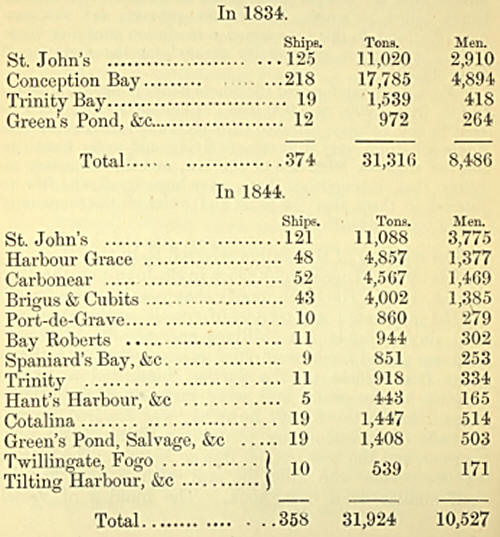
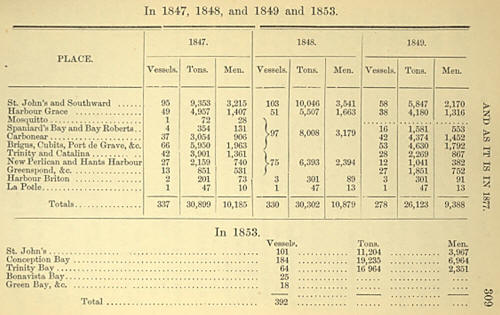
In the year 1871, there
were 201 sailing vessels and 13 steamers, manned by 9,791 men.
The following is the
number of seals landed at the several ports of the island in the spring
of 1839:—
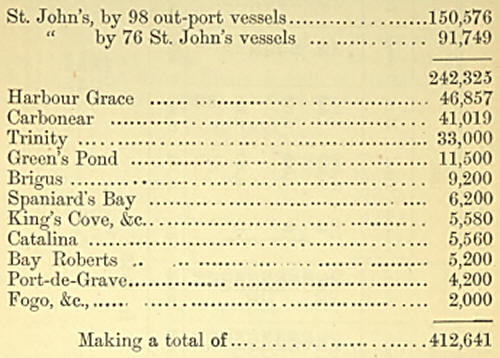
NUMBER OF SEALS
MANUFACTURED AT THE SEVERAL PORTS OF THE ISLAND, UP TO 31ST MAY, 1845.
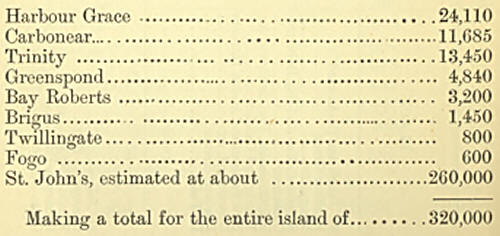
The number of seals
taken at different periods was as follows:—
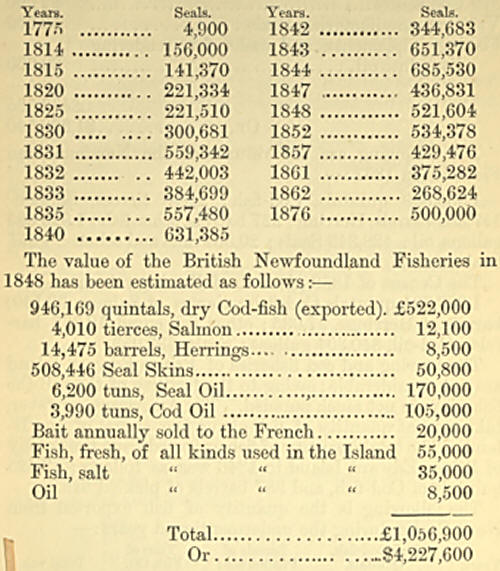
The produce of the
fisheries in the District of Gaspd, and the Magdalen Islands in 1836,
consisted of Cod, 100,542 quintals ; Cod oil, 37,162 gallons; Whale oil,
25,120 gallons, besides salmon and other fish, the whole amounting in
value to £86,624, or $336,496.
Captain Fair of H.M.S.
Champion, in 1839, says, when speaking of the Magdalen Islands,—
“We found tlie herring
fishing had commenced, and was in active operation in the several parts
of the Bay (chiefly in the little harbours of Amherst and House Harbour)
by about 146 sail of American fishing schooners, of from sixty to eighty
tons, and each carrying seven or eight men. Among them were not more
than seven vessels belonging to the British possessions, and they
chiefly from Arichat. The quantity of herrings was very great, exceeding
that of any former years, and the expertness and perseverance of the
American fishermen were far beyond that of the Arichat men* It is
computed that the American fishing schooners average nearly 700 barrels
each, and the barrel is valued at one pound sterling, making, for the
146 sail then in the Bay, a presumed product of 100,000 barrels, value
£100,000 sterling ; the tonnage employed about 10,000 ; and the number
of men about 1,000.
“Between the last end
of Prince Edward Island, to within seven leagues of the Bay of Chaleur,
we passed through a fleet of from 600 to 700 sail of American fishing
schooners, all cod fishing ; it had not been a fortunate season for them
and great numbers had gone towards the Straits of Belle Isle for better
success.
“The house of Janvrin &
Co., at Gaspd, exported in the year 1836 from 15,000 to 20,000 quintals
of Cod-fish, chiefly for the Brazils and South America. Other minor
establishments export largely also—perhaps from Gasp6 and its
neighbourhood the whole export may be about 40,000 quintals.”
In the District of
Gasp6, Cod-fishing is divided into the summer and fall fishing. The
former begins in May, and last till the 15th of August. The fall fish is
either dry, salted or pickled in barrels, the greater part of which is
sent to the Quebec Market.
When the writer
arrrived at Paspebiac in the Bay of Chaleurs, District of Gasp6, in
1864, he found over a dozen barques, brigs and schooners, most of them
taking in fish for the foreign markets.
Here is situate two of
the largest fish establishments in Canada. The business is conducted in
the same manner as the large out-harbour establishments in Newfoundland
in the olden times. Here is the well known firm of Charles Robin & Co.,
of St. Helier’s, Island of Jersey, which was established in 1768. They
have branch establishments at Perc£, Caraquette and other places. They
export from 40,000 to 45,000 quintals of dried codfish, to the various
markets of Spain, Portugal, Brazils, West Indies and Mediterranean
Ports, besides 30,000 gallons of oil, herring, salmon, etc. The Messrs.
Le Boutillier Brothers have also branch establishments at Bonaventure
Island and Labrador, and export altogether about 25,000 or 30,000
quintals dried codfish, besides herrings, salmon and furs. Here is also
the firm of Daniel Bisson, and several minor establishments.
Besides the Canadian
ocean fishery, a very extensive fishery, in salmon trout, white fish,
pickerel, pike, bass etc., is caried on in the Canadian great fresh
water lakes and rivers. The Canadian codfish is small compared with
Newfoundland and neither so firm nor so fat, and the reason of the Gaspd
fish commanding a higher price in the foreign market, is because it is
taken and cured in smaller quantities, and less salted than the
Newfoundland fish.
The river fisheries
carried on off the coast of the Gulf of St. Lawrence, and of the Lower
St. Lawrence, at the island of Anticosti, at the Magdalen Islands, and
on the Gasp6 coast, form an extent of over 900 miles of sea coast,
inhabited by a population of over 35,000 English, Scotch, Irish,
Jerseymen, and French Canadians; the last named predominate. The coast
is frequented each year between the opening and closing of navigation by
more than 1,500 fishing schooners from Nova Scotia, New Brunswick,
Prince Edward Island, and the United States, manned by at least, 20,000
sailors, 'who go there for the purpose of carrying on the cod, herring
and mackerel fisheries.*
The amount of fishing
bounties paid by the Canadian Government in 1863, was 9,769 dollars.
The fishery expenditure
from the 1st July, 1864, to 30th June, 1865, was in Lower Canada 17,500
dollars, including a sum of 6,938 dollars paid for fishery bounties for
the year 1864; and in Upper Canada, 1,053 dollars. The collections made
in Lower Canada (from fishery licenses), during the same period amounted
to 4,854 dollars; and in Upper Canada, 816 dollars.
M. H. Perley, Esq., Her
Majesty’s British Commissioner for the Fisheries at St. John, New
Brunswick, very politely sent me a copy of his Report on the Fisheries
of New Brunswick, from which I make the following extracts :—
“Just within Shippagan
Gully, on Shippagan Island, in a well sheltered and very convenient
position, is the fishing room of Messrs. Wm. Fruing & Co., of Jersey, of
which Captain George Alexandre, of Jersey, was found in charge. At this
place there were sixty boats engaged in fishing, averaging two men and a
boy to each boat. It was stated, that each of these boats would probably
take 100 quintals of fish during the season, but that the boats
belonging to the firm, manned by Jer-seymeu, would take more. On the
21st August there were at this ‘ room ’ 2,500 quintals of dry fish,
exceedingly well cured. On the day it was visited there were 600
quintals of cod spread out to dry; they were exceedingly white and hard,
of the finest quality, and were about to be shipped to Naples, lor which
market the very best fish are required. They are shipped in bulk, and
the manner in which they are stowed in the holds of the vessels is very
neat and compact. It requires great skill and care to stow them without
breaking, and in such a manner as to prevent their receiving damage on
so long a voyage; but long practice and experience have conquered these
difficulties, and cargoes are rarely injured by bad stowage.
“The ling cured at this
establishment are sent to Cork tor the Irish market; and the haddock to
the Brazils. The first quality cod cured here in 1848, instead of being
sent to Naples were shipped to the Mauritius; it was not stated what
success had attended this adventure.
“Nearly all the
fishermen at this establishment were French settlers, who had small
farms, or patches of land, somewhere in the vicinity, which they
cultivated. It was the opinion of Captain Alexandre, that the fishermen
could not live unless they possessed land, and obtained something from
the soil; if they did not, they nearly starved. Those who are too poor
to own boats hire them of the firm for the season, that is, until the
15th of August, when the summer fishing ends. If the boats are used for
the autumn or ‘ fall' fishing, there is, of course, another hiring.
“The fishing usually
continues until the 15th October, and it was expected that the whole
catch of the season of 1849 would amount to 3,500 quintals—if the
weather proved favourable, probably 4,000 quintals.
“The boats come in here
directly to the ‘stage head,’ upon which the fish are thrown ; they are
at once split and cleaned by the fishermen, on tables provided for the
purpose; and 300 lbs. of fish fresh from the knife, are weighed off as
sufficient to make a quintal of dry fish, with the allowance of
One-tenth for the curer. If the fish are split and salted in the boats,
and lay one night, then 252 lbs. are weighed as a quintal. The fishermen
are allowed for a quintal of cod thus weighed, ten shillings, and for
ling and haddock, five shillings,—the amount payable in goods at the
store of the firm, on Point Amacque, where a large quantity of foreign
goods is kept of every variety. Here were found Jersey hose and
stockings—Irish butter— Cuba molasses—Naples biscuit, of half a pound
each—Brazilian sugar—Sicilian lemons—Neapolitan brandy—American
tobacco—with English, Dutch, and German goods,—but nothing of Colonial
produce or manufacture, except Canadian pork and flour.
“Some of the residents
at Shippagan, who are in more independent circumstances, prosecute the
fisheries in connection with their farming, curing the fish themselves,
and disposing of them at the close of the season to the Jersey
merchants, or to others, as they see fit.
“All the men engaged in
this fishery are also part farmers ; they cultivate some portion of land
wherever they reside on the coast. Of the quantity of dried fish above
stated, it is estimated that 15,000 quintals were cod, and the rest
haddock and ling.
“The ling is a fish
known in the Bay of Fundy by the name of ‘ Hake.’ In the Gulf this fish
is taken of very large size, especially by fishing during the night. In
appearance it corresponds precisely with the drawing in Mr. Yarrell’s
admirable work on British Fishes, (vol. 2, page 289,) and its
description is the same as there given of the forked hake ; or phycis
furcatu8 of Cuvier. Owing to the length, breadth and thickness of the
ling when split, they are, at the best ‘ rooms,’ dried on large flakes,
raised about eight feet from the ground, which have a greater
circulation of air underneath. The cod of larger size are also dried on
these flakes.
“Of the quantity of
fall herring taken on this coast, it is quite impossible to give any
estimate which may be relied upon as accurate. The principal fishing
ground is at Caraquette, and the whole quantity taken there in 1849,
would probably amount to two thousand barrels, or perhaps exceed that
quantity. The catch at other localities along the coast, would perhaps,
amount to one thousand barrels more.
“The quantity of
mackerel caught and cured, is so small as scarcely to be taken into
account, in giving an estimate of these fisheries. It was said that
mackerel had at times been imported from Arichat for the use of the
inhabitants on this coast, near which thousands of barrels, of the same
fish, are annually caught by fishing vessels from Maine and
Massachusetts.”“ The value of all imports at the port of Gasp6 in 1849,
was £32,286 currency ; the value of exports the same year, was £51,880
currency. At New Carlisle, the value of imports from abroad, in 1849,
was £12,511 sterling; the value of exports was £37,250. The imports and
exports to and from Quebec are not stated in the return from New
Carlisle. The exports include birch and pine.
Fisheries of the United
States.
The number of persons
employed in the New England States before the revolution was about
4,000, which was prosecuted in small craft. The quantity caught was
about 350,000 quintals, of the value of £200,000,
“The Americans follow
two or more modes of fitting-out for the fisheries. The first is
accomplished by six or seven farmers or their sons building a schooner
during the winter, which they man themselves (as all the Americans on
the sea-coast are more or less seamen as well as farmers), and after
fitting the vessel with necessary stores, they proceed to the banks,
Gulf of St. Lawrence, or Labrador, and loading their vessels with fish,
make a voyage between spring and harvest. The proceeds they divide,
after paying any balance they may owe for outfit. They remain at home to
assist in gathering their crops, and proceed again for another cargo,
which is salted down and not afterwards dried—this is termed mud-fish,
and kept for home consumption. The other plan is, when a merchant, or
any other owning a vessel, lets her to ten or fifteen men on shares. He
finds the vessel and nets. The men pay for all the provisions, hooks and
lines, and for the salt necessary to cure their proportion of the fish.
One of the number is acknowledged master, but he has to catch fish as
well as the others, and receives only about twenty shillings per month
for navigating the vessel; the crew have five-eighths of the fish
caught, and the owners three eighths of the whole.”
For a more detailed
account of the fisheries of Massachusetts and the United States, see “A
Peep at Uncle Sams Workshop, Fisheries, &c.,” by the Author.
The annual quantity of
cod-fish exported from the United States is about 200,000 quintals,
which is principally sent to Cuba, Hayti, West Indies, and Madeira. In
1851, 502 ships, 24 brigs, and 27 schooners of the aggregate tonnage,
171,971, were employed in the whale fishery of the United States. An
important fishery is carried on in the interior lakes of America,
principally on Lake Huron, Lake Superior, Mackinac and Detroit River.
The kind of fish caught is sturgeon, salmon-trout, Maskinonge, pickerel,
mullet, white-fish, bass, pike, perch, &c. Some of these fish weigh from
one to 120 lbs. The quantity of fish taken on these lakes in 1840 was
35,000 barrels, amounting in value to 256,040 dollars.
Mr. McGregor, in his
“Progress of America,” says :—
“The British whale
fishery, formerly so very extensive, has, from causes which have
developed their effects during the last ten years, declined rapidly ;
and there is every probability that both the northern and southern
British whale fishery will be discontinued from the ports of the United
Kingdom. The substitution of vegetable and lard oils, and stearine from
lard, the great outlay of capital in the southern whale fishery, the
long period which must expire before any return can be realized for the
expenditure, constitute the chief causes of the decline of the whale
fishery from British ports. The Dutch whale fishery disappeared in the
early part of the present century ; the French whale fishery is only
maintained by bounties taken from the national taxes, and we can
scarcely hope that it can ever be revived so as to constitute a
profitable pursuit from any port in Europe. The bounties paid in support
of the British whale fishery, according to McPherson, from 1750 to 1788
amounted to £1,577,935 sterling; and Mr. McCulloch estimates that more
than £1,000,000 has been paid after that period, so that more than
£2,500,000 sterling have been paid by the nation for bounties to the
whale fishery.”
The number of ships
engaged in the northern and southern whale fisheries during the years
1843, 1844 and 1845 were as follows:—
|
Northern
Fishery. |
Southern
Fishery. |
|
Years. |
No. Ships. |
Years. |
No. Ships. |
|
1843 |
24 |
1843 |
50 |
|
1844 |
32 |
1844 |
47 |
|
1845 |
34 |
1845 |
44 |
Twenty-one ships are
engaged in the southern fisheries from the Australian colonies. Six
ships from St. John, New Brunswick, and one ship from Halifax, Nova
Scotia.
The next important
fisheries to those of America are those of Norway in Europe.
“The fisheries of
Norway supply an important branch of exportation, and for these
pursuits, their extensive seas and deep, commodious bays afford
unlimited opportunities. In the neighbourhood of the Lofoden Isles more
than 20,000 men find employment during the months of February and March
in taking herrings and cod. At that season the fish set in from the
ocean and settle on the West Fiord banks, which run from three to ten
miles out into the water, at a depth of from sixty to eighty fathoms.
Such swarms collect for depositing their spawn, attracted by the
shelter, or perhaps some special circumstances in the temperature, that
it is said a deep sea-lead is frequently interrupted in its descent to
the bottom through these shoals (or fiskebierg, mountains of fish, as
they are called) which are found in layers, one over the other, several
yards in thickness. From North Cape to Bergen, all the fishermen who
have the means assemble at the different stations in January.
Every twenty or thirty
of these companies have a yacht or large tender to bring out their
provisions, nets and lines, and to carry their produce to the market.
Their operations are regulated by statutes contained in several ancient
codes, and, more lately by that of the 4th of August, 1827. These laws
prescribe the order and limits to be observed in fixing the stations,
the time for placing and removing the nets, and also for preparing,
salting and drying the fish. Nets, and long lines of L20 hooks at five
feet distance are used, but there is a difference of opinion which of
the two outfits is the more advantageous. The period when the season
ends is appointed by law on the 12th of June, when Lofoden and its busy
shores become deserted and desolate. The fish are prepared in two ways.
They are cured as round or stock-fish until April, after which they are
split, salted and carried to the coasts above Trondheim, or other
places. There are large flat rocky mountains, with a southern aspect,
upon which they are spread and exposed to the sun to dry. This
preparation is called klip fish, and in fine seasons is completed in
three or four weeks. The livers are used for oil, one barrel of which
may be the produce of from 200 to 500 fish according to their fatness.
The number taken is immense. In a medium year (1827) there were 2,916
boats employed in 83 different stations, accompanied by 124 yachts, with
15,324 men. The produce was 16,456,620 fish, which would be about 8,800
tons dried; there were also 21,530 barrels of cod-oil, and 6,000 of
cod-roe. Sir A. Brooks reckoned the quantity taken in a year at 700,000,
worth about £120,000, but other writers value them at £250,000 or even
£300,000. An English lobster company was established some years ago on
the west coast, and twice or thrice a week their packets sailed from
Christiansand to London. In 1830 the number of these animals exported
was 1,196,904; of roes, 21,682 barrels; of dried fish, 425,789 quintals
; and of salted fish, 300,218 barrels. The herring fishery is also an
important and thriving branch of industry. In 1819, the exports were
240,000 tons. But in 1835, which was more productive than the five or
six preceding years, they amounted to 536,000, an increase the more
remarkable considering that the population and the internal consumption
had both been augmented during that period.’’
Considerable fisheries
are carried on at British Columbia, Puget’s Sound, Alaska, and adjacent
places. Hudson Bay, at some future day, bids fair to rival the
Newfoundland fisheries. For several years past, American vessels have
resorted there for cod fishing. Salmon, herring, caplin, and other
varieties of fish abound there. At Two Rivers the Hudson Bay Company
carried on porpoise fishing for several years, where 7,749 porpoises
were taken, giving an aggregate of 193,689 gallons, or 768\ tons of oil,
worth in England upwards of £27,000 sterling.3
A new market has recently been found for herring in Sweden, several
cargoes having been shipped there from Gloucester, Massachusetts, U.S.,
and found remunerative.
